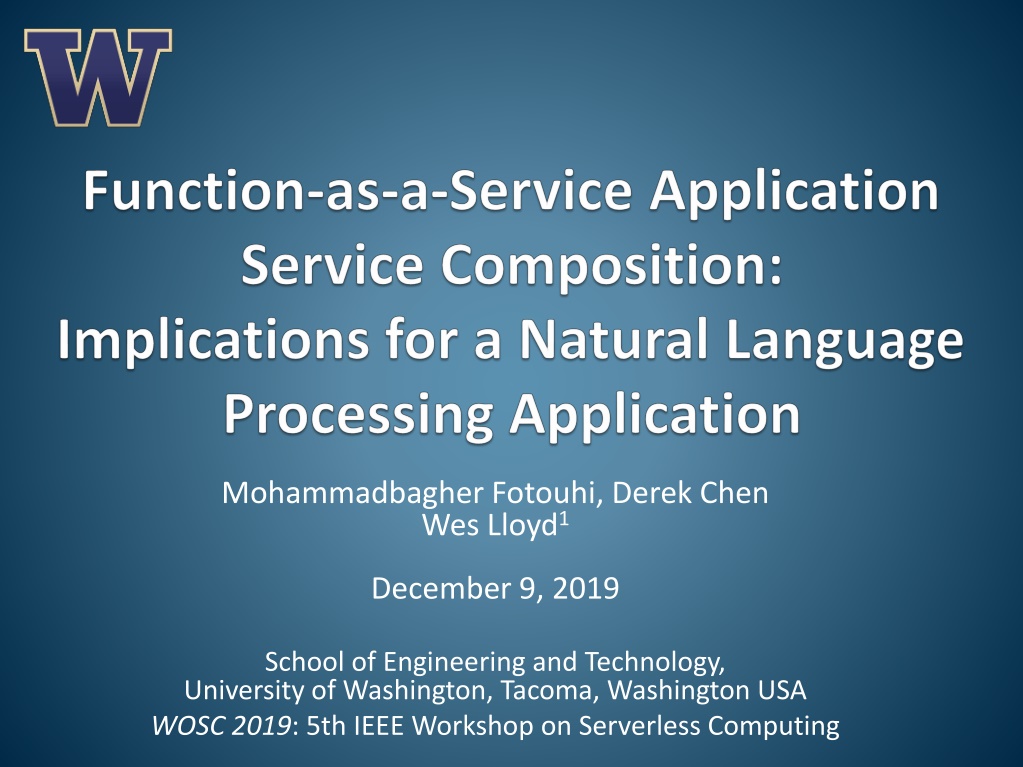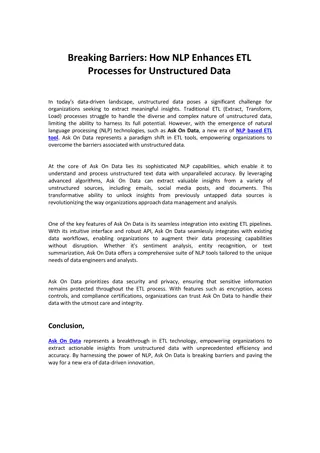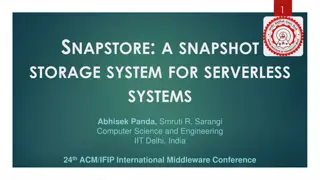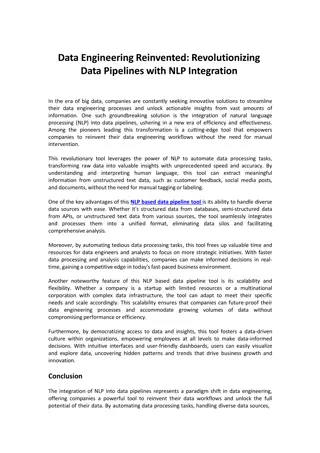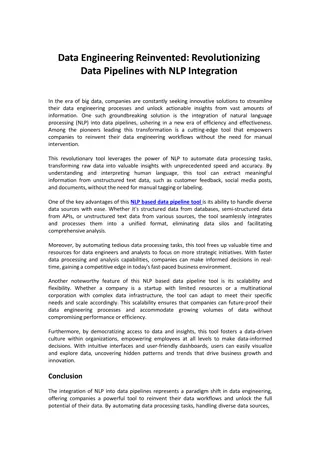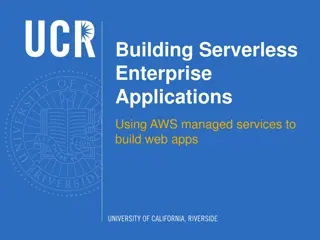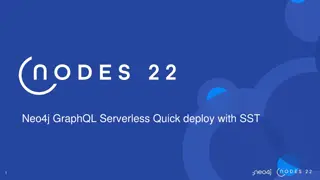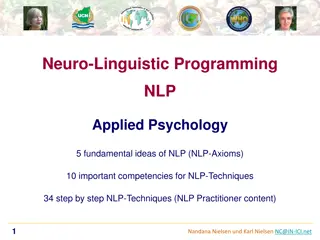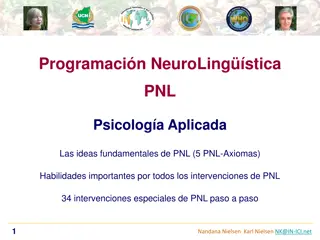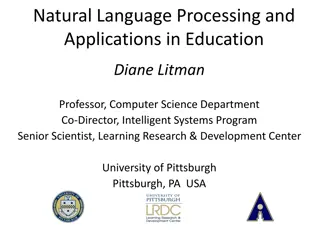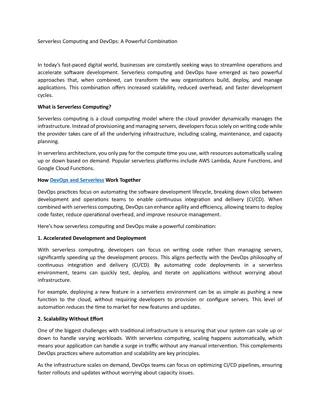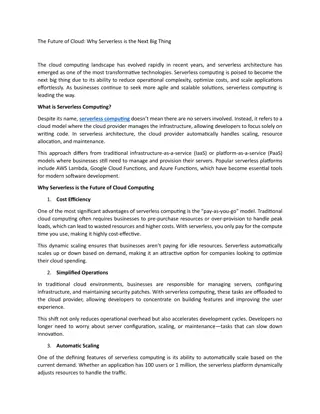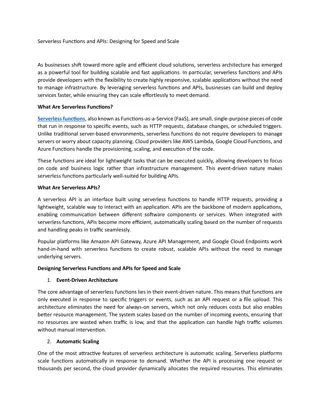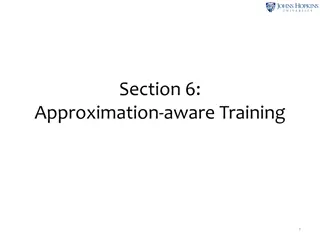Exploring Serverless Computing for NLP Application Deployment
The presentation discusses the utilization of Function-as-a-Service (FaaS) platforms in the context of Natural Language Processing (NLP) applications. It delves into the implications of memory reservation, service composition, and adjustment of neural network weights in enhancing NLP application deployment efficiency and scalability.
Download Presentation

Please find below an Image/Link to download the presentation.
The content on the website is provided AS IS for your information and personal use only. It may not be sold, licensed, or shared on other websites without obtaining consent from the author. Download presentation by click this link. If you encounter any issues during the download, it is possible that the publisher has removed the file from their server.
E N D
Presentation Transcript
Mohammadbagher Fotouhi, Derek Chen Wes Lloyd1 December 9, 2019 School of Engineering and Technology, University of Washington, Tacoma, Washington USA WOSC 2019: 5th IEEE Workshop on Serverless Computing
Outline Background Research Questions Experimental Implementation Experiments/Evaluation Conclusions December 9, 2019 2 WOSC 2019: FaaS Application Service Composition: Implications for an NLP Application 2
How can computers be used to understand speech? Image from: https://aliz.ai/natural-language-processing-a-short-introduction-to-get-you-started// 3
NLP Dialogue modeling components Intent Tracking Determines what the user wants Policy Management Choose the agent action Text Generation Generate the actual text December 9, 2019WOSC 2019: FaaS Application Service Composition: Implications for an NLP Application 4
NLP Dialogue modeling components Considering a scenario where a user asks : What is Milad sphone number ? Intent tracker -> Question Policy Management -> To answer Text generator -> The number is 123-456-7890 These phases include an initialization and inference step December 9, 2019WOSC 2019: FaaS Application Service Composition: Implications for an NLP Application 5
Image from: https://mobisoftinfotech.com/resources/blog/serverless-computing-deploy-applications-without-fiddling-with-servers/ 6
Serverless Computing Function-as-a-Service (FaaS) platforms New cloud computing delivery model that provides a compelling approach for hosting applications Bring us closer to the idea of instantaneous scalability Our goals- research implications of: Memory reservation Service composition Adjustment of neural network weights In the context of NLP application deployment December 9, 2019WOSC 2019: FaaS Application Service Composition: Implications for an NLP Application 7
Nov 17, 2017 Memory Reservation Lambda memory reserved for functions UI provides slider bar to set function s memory allocation Resource capacity (CPU, disk, network) coupled to slider bar: every doubling of memory, doublesCPU Performance How does memory allocation affect performance? December 9, 2019WOSC 2019: FaaS Application Service Composition: Implications for an NLP Application 8 8
Infrastructure Freeze/Thaw Cycle Unused infrastructure is deprecated But after how long? AWS Lambda: Bare-metal hosts, firecracker micro-VMs Three infrastructure states: Fully COLD (Cloud Provider/Host) Function package transferred to hosts Runtime environment COLD Function package cached on Host No function instance or micro-VM WARM (firecracker micro-VM) Function instances/micro-VMs ready Performance Image from: Denver7 The Denver Channel News December 9, 2019WOSC 2019: FaaS Application Service Composition: Implications for an NLP Application 9
Service Composition How should applications be composed for deployment to serverless computing platforms? Switchboard / Asynchronous Service isolation Fully aggregated (Switchboard) and fully disaggregated (Service isolation) composition Platform limits: code + libraries ~250MB How does service composition affect freeze/thaw cycle and impact performance? Performance December 9, 2019WOSC 2019: FaaS Application Service Composition: Implications for an NLP Application 10
Outline Background Research Questions Experimental Workloads Experiments/Evaluation Conclusions December 9, 2019WOSC 2019: FaaS Application Service Composition: Implications for an NLP Application 11 11
Research Questions RQ1: MEMORY: How does the FaaS function memory reservation size impact application performance? COMPOSITION: How does service composition of microservices impact the application performance? RQ2: December 9, 2019WOSC 2019: FaaS Application Service Composition: Implications for an NLP Application 12
Research Questions - 2 RQ3: NN-WEIGHTS: How does varying the neural network weights impact the performance of the NLP application? FREEZ THAW LIFE CYCLE: How does the service composition of our NLP application impact the freeze-thaw life cycle? RQ4: December 9, 2019WOSC 2019: FaaS Application Service Composition: Implications for an NLP Application 13 13
Outline Background Research Questions Implementation Experiments/Evaluation Conclusions December 9, 2019WOSC 2019: FaaS Application Service Composition: Implications for an NLP Application 14 14
Aws lambda Inference functions December 9, 2019WOSC 2019: FaaS Application Service Composition: Implications for an NLP Application 15 15
Switchboard architecture Aggregated all 6 microservices in one package Client initiates pipeline Switchboard routine accepts calls and routes internally December 9, 2019WOSC 2019: FaaS Application Service Composition: Implications for an NLP Application 16
Full service isolation architecture Fully decomposed functions as independent microservices Cloud provider provisions separate runtime containers December 9, 2019WOSC 2019: FaaS Application Service Composition: Implications for an NLP Application 17
Application Implementation DisseminateneuralnetworkmodelswithAWS S3 AWS CLI based client for submitting requests Leveraged AWS EC2 s Python Cloud9 IDE to identify and compose dependencies Packaged dependencies as ZIP for inclusion in Lambda FaaS function deployment Conformed to package size limitations(<250MB) December 9, 2019WOSC 2019: FaaS Application Service Composition: Implications for an NLP Application 18 18
Outline Background Research Questions Experimental Workloads Experiments/Evaluation Conclusions December 9, 2019WOSC 2019: FaaS Application Service Composition: Implications for an NLP Application 19 19
How does varying the neural network weights impact the performance of the NLP application? 20
Nov 17, 2017 Runtime performance Switchboard c4.2xlarge average of 8 runs Running the inferences is the performance and memory bottleneck. Increasing the number of samples increases the runtime. The Intent tracker initialization is slower than the other initialization phases. Performance range: 22.46 sec for 3 samples , 92.31 sec for 1,000 samples - throughput (samples/second) increased ~81x. Coefficient of variation (CV) ~ 6.3%. December 9, 2019WOSC 2019: FaaS Application Service Composition: Implications for an NLP Application 21 21
Nov 17, 2017 Runtime performance Service Isolation Initialization phases, all have the same performance. In all cases, the performance bottleneck is running the network. Runtime increases with larger input data sizes. Performance range: 14.19 sec for 3 samples, 108.29 sec for 1,000 samples - throughput (samples/second) increased ~43x. Coefficient of variation (CV) averaged 12.6% c4.2xlarge average of 8 runs December 9, 2019WOSC 2019: FaaS Application Service Composition: Implications for an NLP Application 22 22
How does the FaaS function memory reservation size impact application performance? 23
Nov 17, 2017 Memory Utilization Switchboard Max Memory used (MB) C4.8xlarge 36 vCPU client December 9, 2019WOSC 2019: FaaS Application Service Composition: Implications for an NLP Application 24 24
Memory Utilization Service isolation Max Memory used (MB) December 9, 2019WOSC 2019: FaaS Application Service Composition: Implications for an NLP Application 25
How does service composition of microservices impact the application performance? 26
Performance Comparison Switchboard performed more efficiently over larger input dataset sizes. As the input data size grows, the switchboard outperforms the service isolation. The service isolation architecture runtime performance normalized to switchboard : 63.2% : 3 samples- 73% : 10 samples- 84% : 30 samples- 91.5% : 100 samples- 94.6% : 300 samples- 117.3%: 1000 samples Memory sizes Memory sizes tested: 192, 256, tested: 192, 256, 384, 512 MB 384, 512 MB December 9, 2019WOSC 2019: FaaS Application Service Composition: Implications for an NLP Application 27
Outline Background Research Questions Experimental Workloads Experiments/Evaluation Conclusions December 9, 2019WOSC 2019: FaaS Application Service Composition: Implications for an NLP Application 28 28
Conclusions Switchboard architecture minimized cold starts Switchboard performed more efficiently over larger input dataset sizes vs. service isolation 14.75 % faster for 1,000 samples 17.3% increase in throughput When inferencing just 3 samples, the service isolation architecture was faster 36.96% faster for 3 samples 58% increase in throughput full service isolation not always optimal December 9, 2019WOSC 2019: FaaS Application Service Composition: Implications for an NLP Application 29
